No products in the cart.
Return To ShopWhales: Did they Evolve from Land Creatures??
Natural history museums promote the idea that whales evolved from any number of possible mammal ancestors. Charles Darwin began the list of possible whale ancestors in the 1800s when he proposed that whales evolved from bears because they could be observed “swimming for hours with a widely open mouth, thus catching, like a whale, insects in the water.” He believed that natural selection eventually led to bears to becoming “more and more aquatic in their structure and habits, with larger and larger mouths, till a creature was produced as monstrous as a whale.”[i]
Darwin’s bear-to-whale idea was replaced in 1883 when Dr. Flowers pitched the idea that hoofed mammals turned into whales. In 1966, Dr. Van Valen narrowed this down to an extinct order of hoofed mammals called of Mesonychids, which he considered the most likely ancestor for whales.
Fast forwarding to the last couple of decades, leading evolutionists have developed all kinds of varying ideas about where whales come from, with the California Academy of Sciences claiming they came from creatures that look like hyenas, the Tokyo Institute of Science saying they came from a hippo-like creature, the University of Michigan claiming whales came from something that looked like a cat, the Carnegie Museum saying something like a wolf, a deer at the Melbourne Museum, and something like a lion at the American Museum of Natural History. Does it sound like some guess work is at play here? In fact, over the years, evolutionists have proposed four different mammal orders as the possible starting place for whales (see Table 1).
Table 1. Will the Real Whale Ancestor Please Stand Up?[ii]
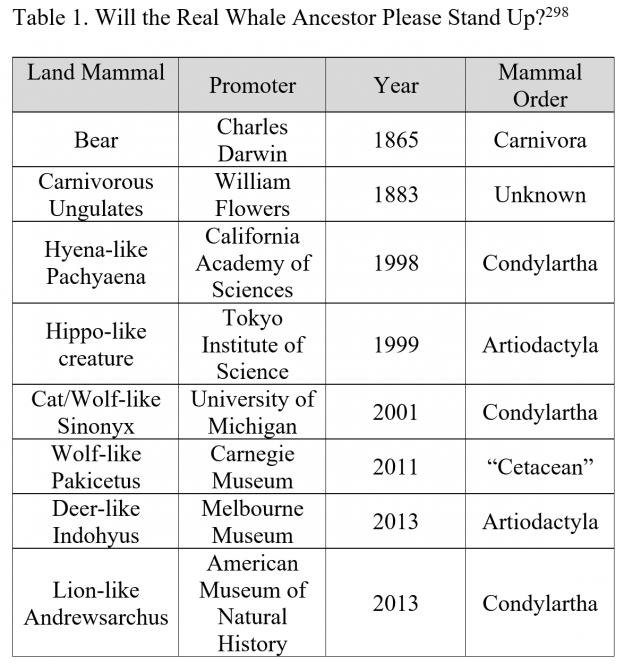
Today most museums present just the broad category of cloven-hooved mammals called Artiodactyls as the beginning of the whale line. This exempts them from having to choose a specific animal because this order includes cattle, deer, camels, pigs, goats, giraffes, antelopes, and sheep.[iii]
But how reasonable is this theory? I mean, let’s think about this for a minute: this theory claims that some unknown land mammal evolved into the dozens of whale varieties we see today—all the way from small Maui dolphins to 100-foot long blue whales weighing over 360,000 pounds.[iv]
Blue whales have a tongue the size and weight of an African elephant and a heart the size of a small car that pumps over 2,000 gallons of blood.[v] They can swim 30 miles per hour and dive to depths of 1,500 feet while holding their breath, and they do this with an uncanny efficiency that baffles scientists today. Does it really make sense that such an ocean-fit creature evolved from a land-dwelling mammal? To go from a land mammal to a giant blue whale, some serious changes would need to take place. Here is an abbreviated list: growing from 5–6 feet long to over 100 feet, weighing less than 150 pounds to over 360,000 pounds, diving less than eight feet under water to over 1,500 feet and special collapsing lungs to be able to do this, changing from teeth to baleen filters, going from a tubular tail to a wide fluke for propulsion by means of a ball vertebra[vi] so it can move up and down instead of side to side, along with a new package of muscles and new chevron bones to connect them to, going from front legs for running to flippers for steering and losing the back legs altogether, moving the nasal passages from the tip of the snout to the top of the head, going from intaking fresh water to salt water and changed kidneys to handle it, insulation from fur to blubber, external to internal ears capable of hearing other whales 500 miles away,[vii] moving reproductive organs from outside to inside the body and adding special, radiator-like cooling systems so they can even work, modified mammae for nursing young underwater, hydrodynamic skin, developing blowhole muscles, modifying the eye for underwater vision, reorganizing skull bones and muscles, and decoupling the esophagus and trachea. And this is just a starter list.
When it comes to the number of changes to go from a land mammal to a whale, biologist Richard Sternberg remarked, “Just think of all the parameters that would have to be modified and then multiply that by a thousand fold or more than that—that’s the scale of the problem that you’re dealing with in the context of Darwinian evolution.”[viii] One of these complex changes would be moving the reproductive organs to inside the body and somehow cooling them when they’re right next to the swimming muscles that generate heat. Dr. Sternberg remarks that this system:
Has a remarkable solution to that problem—it’s a miraculous web of arteries and veins, but can you explain it by some smooth gradualist textbook scenario, little change little change fixation? No—it doesn’t fit the Darwinian model in my opinion. You’re looking at just a suite of characteristics that had to have been integrated from the get-go. I mean it’s a non-gradualistic type of change. So the cooling system makes sense because you have internalized reproductive glands. The internalized reproductive glands, however, are a no-go unless you’ve got the cooling system. You can’t explain the emergence of one without the other.[ix]
Looking at the bigger picture, Dr. Sternberg applied mutational genetic models from Cornell University and determined that it would take over 100 million years to randomly generate just a single pair of “cooperative mutations” that could lead to only some of the changes necessary to move from a land mammal to a whale. So, if it would take over 100 million years to produce just two coordinated mutations but thousands more are required to turn a land mammal into a whale, there’s certainly no way it can happen in the nine million years that evolutionists believe it took for land mammals to turn into whales.
The Whale Fossil Record
But what about the fossil record? Does it reflect a clear progression that moves from land mammals to whales? Famous evolutionist Richard Dawkins has a short video on YouTube that overviews the typical evolutionary whale story:
People often say, “Where are the intermediate fossils? Show us your intermediate fossils.” There are plenty of intermediate fossils, and one of the best examples is whales… Here’s a series of fossils back in time: Dorudon about 36 million years ago, Rodhocetus about 47 1/2 million years, Pakicetus about 48 1/2 million years. And you can see they form a lovely series of intermediates. As you go from old to young, Pakicetus, Rodhocetus, you’re gradually losing the hind legs to Dorudon, which has almost lost the hind legs completely. Modern whales have completely lost the hind legs. There are some vestigial bones, some remnant bones buried deep inside the body. A lovely series of intermediates getting progressively more and more specialized in living in the sea. If you look at Pakicetus, which is an old fossil whale, you see that the nostril is just about where you’d expect the nostril to be, near the tip of the snout. If we move on a million years to Rodhocetus, you see that the nostril has moved backwards, backwards on the skull, backwards along the snout. Now if you look at a modern whale—that’s a dolphin, a modern dolphin—you see that the nostril is right up near the top of the head. That’s the blowhole. The nostril has moved right backwards. Now, a really surprising thing is which animal is the most closely related to modern whales among modern animals, and the answer, astonishingly, is the hippopotamus, which is classified in the even-toed ungulates, the cloven-hoofed animals. So what we now believe is that there was an ancestor, which was a cloven-hoofed animal, before 55 million years ago. A little bit before that, the ancestor gave rise to other cloven-hoofed animals. And the later than that, there was a split between the lineage leading to whales and the lineage leading to modern hippopotamuses. It’s molecular evidence as well as fossil evidence that shows that hippos are the most closely related modern animals.[x]
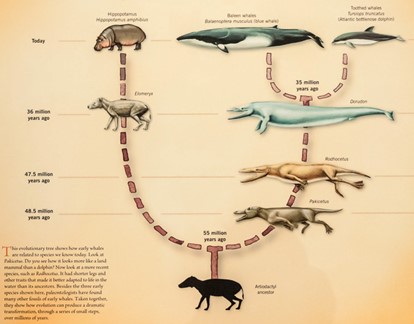
When it comes to Dawkin’s first icon, Artiodactyl, remember that this is just a wide category of “even-toed” animals, including goats, sheep, camels, pigs, cows, and deer. Other than just saying so, there’s no evidence connecting this entire group of animals to whales. By suggesting that whales evolved from some “ancient artiodactyl,” evolutionists admit that they do not have a real fossil connecting whales to other mammals. Instead they reach for an imaginary, not-yet-found “ancestor” and the precise animal that fills this slot depends on which museum you visit.
The next in the line-up is Pakicetus. Dr. Gingerich discovered this creature and named it the “whale of Pakistan,” claiming it was “the oldest and most primitive whale yet discovered.” This bold statement was based on a few parts of the skull that were found, but they had no fossil evidence below the head. Yet this did not stop them from illustrating this creature with flipper hands and feet and a swishy fin for a tail on the front cover of Science (see Figure 93).[xii]
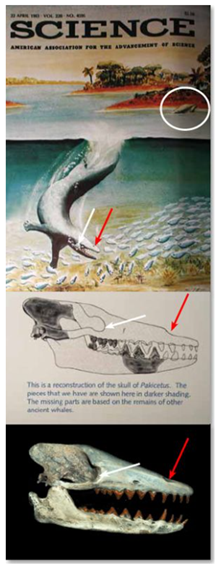
The Smithsonian even boldly displayed it with a blowhole way up the snout and paddlelike feet and hands—all while no fossils of flippers, arm, leg, or lower snout bones had been found!
All this changed by 2001 after four more partial skulls and 150 additional Pakicetus bones had been discovered—all of which proved that this creature was 100 percent land animal.[xiv]

Based on these new findings, researchers even said that pakicetids were good runners, moving with “only their digits touching the ground.”[xvi] These new findings led to the conclusion that Pakicetus was “no more amphibious than a tapir,”[xvii] a browsing mammal living today in South America which is similar to pigs but with longer snouts. Pakicetus models had to be changed to add running legs, hoofed feet and not paddles, a longer neck, eyes on top of its head, and nasal passages were moved from the middle of the snout to the front.
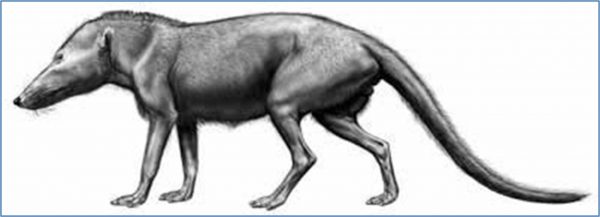
Surprisingly, some museums still display the original while-like Pakicetus, not the 2001 land animal version based on the additional fossil discoveries.

Next we have Rodhocetus, which is based on a fossil found in Pakistan in 1992, and is now represented by three fossil finds.[xx] Many museums and textbooks show Rodhocetus with flippers for feet, a long tail, and a fluke like whales have.[xxi]

Even though they only found a few vertebrae that followed the pelvis, Dr. Gingerich, the paleontologist most responsible for the reconstruction and presentation of Rodhocetus, added flipper feet and a prominent, long tail complete with a whale fluke to the Rodhocetus display at the Natural History Museum at the University of Michigan (see Figure 97). When interviewed about these three whale-like features, Gingerich made some amazing admissions. When questioned how he knew there was a whale fluke on Rodhocetus since that part of the fossil was missing, Dr. Gingerich answered: “Well I told you we don’t have the tail in Rodhocetus so we don’t know for sure whether it had a ball vertebra indicating a fluke or not so I speculated it might have had a fluke.” Gingerich also acknowledged that the flippers were drawn on the diagram without these fossil bones. At the time of the interview, however, he did not believe this animal had flippers, even though the museum diagrams had flippers on Rodhocetus. He admitted that since the discovery they had found the forelimbs (the hands and the front arms) of Rodhocetus and that he believed that it didn’t have the kind of arms that could be spread out like flippers. He also admitted that if such a creature does not have flippers he didn’t believe it could have a fluke tail that really powered swimming. He then admitted that he now doubts that Rodhocetus would have had a fluke tail.[xxii] So—no long tail, no fluke, and no flipper feet. This creature sure doesn’t seem like much of a whale, or even close to becoming one.
Finally, we have Dorudon. These animals are simply extinct whales. They had nostril openings (blowholes) on top of their skulls, measured about 50 feet long, and lived in the water full-time.
Next let’s look at the idea that some whales have vestigial legs or hips that are supposedly “evolutionary left overs” from when whales walked on land. Museums frequently highlight these structures in whale skeletons, claiming this evolutionary story along with them. Typical book figure and museum captions say something like, “the whale retains pelvic and leg bones as useless vestiges” (see Figure 98).[xxiii]
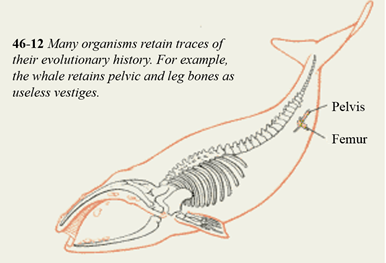
One high school biology book states, “Vestigial Structures are inherited from ancestors but have lost much or all of their original function due to different selection pressures acting on the descendant.”[xxv] So, for the “pelvic bones” in whales and dolphins, this implies that its ancestor used to walk on land, but once they evolved to live in water, they have useless, leftover hip bones. Ironically, a 2014 article in the journal titled Evolution admits that these so-called leftover pelvic/hip bones are actually “claspers” that are very important in the mating process![xxvi] It appears that God placed these bones in whale bodies for reproduction. From now on, even calling them “hip” bones reveals ignorance of their function. So much for one of evolution’s top examples.
What we can know for certain regarding the supposed story of whale evolution is that its theories have often changed—bears, mesonychids, Pakicetus, and several different mammal orders rotated through as the possible ancestors. The Biblical viewpoint, however, remains unchanged: Whales were created as whales just thousands of years ago on the Fifth Day of Creation week. The different whale kinds express variation but stay within their created kinds. Some of them did not survive the Flood or long into the post-Flood world, but many are still alive today, filling the Earth with God’s glory.
[i] Darwin, Charles. The Origin of Species 1st ed. (1865): Chapter 6, 184.
[ii] Table adapted from Werner, Evolution: The Grand Experiment (Vol. 1) (2014), p. 274–275.
[iii] “Order Artiodactyla Even-toed ungulates and whales!” The Ultimate Ungulate. https://www.ultimateungulate.com/Artiodactyla.html. Accessed September 23, 2020. See also Wikipedia: https://en.wikipedia.org/wiki/Evolution_of_cetaceans
[iv] Ibid.
[v] Werner, Evolution: The Grand Experiment, p. 40.
[vi] Werner, Evolution Grand Experiment, p. 40: “A scientist can tell if an animal had a whale’s widened tail fluke by looking at the bones of the tail. A whale’s tail has a special round “ball” vertebrae, followed by several flat bones where the cartilaginous fluke tail attaches…Without a ball vertebrae, a scientist could not be sure if Rodhocetus, in fact, had a fluked tail.
[vii] “Animal-Reference: Blue Whale.” National Geographic. www.nationalgeographic.com/animals/mammals/b/blue-whale/. Accessed September 23, 2020.
[viii] “Whale Evolution vs. Population Genetics – Richard Sternberg and Paul Nelson.” Posted August 19, 2016. Living Waters Intelligent Design in the Oceans of the Earth (excerpt posted on “Philip C” YouTube Channel). Produced by Illustra Media (2015) YouTube. https://youtu.be/0csd3M4bc0Q. Accessed September 23, 2020. Narrative from excerpt states: “Could random chance, natural selection, and millions of years explain all these differences? That’s certainly not what leading evolutionary biologist Dr. Richard Sternberg believes. Dr. Sternberg concluded that—even under the evolutionary idea of millions of years—there’s just not enough time to make even a few of the changes necessary to change such a land creature into a whale. Dr. Sternberg stated in a debate, ‘How could this process alone have produced fully aquatic cetaceans (whales) with their multiple, anatomical novelties, requiring many hundreds, even thousands of adaptive changes in less than 2 million years—even less than 9 million years?…I’m saying it doesn’t add up.” We would need thousands of in-between examples of fossils demonstrating each of these requirements developing through time.”
[ix] Ibid.
[x] ‘Richard Dawkins: Show Me the Intermediate Fossils! – Nebraska Vignettes #1.” Posted June 5, 2014. YouTube. https://youtu.be/DP53WAkQ5Yc. Accessed September 23, 2020.
[xi] Whale Evolution Display at the Nebraska State Natural History Museum (Copyright Earl L. Miller).
[xii] Gingerich, Phil. “Evidence for Evolution from the Vertebrate Fossil Record.” Journal of Geological Education 31 (1983): 140–144.
[xiii] Ibid.
[xiv] Thewissen, J.G.M., Williams, E.M., Roe, L.J., and Hussain, S.T. “Skeletons of terrestrial cetaceans and the relationship of whales to artiodactyls.” Nature 413 (September 20, 2001): 277–281.
[xv] Ibid.
[xvi] As published in Nature.
[xvii] Thewissen, G.M., Williams, E.M., Roe, L.J. & Hussain, S.T. “Skeletons of Terrestrial Cetaceans and the Relationship of Whales to Artiodactyls,” Nature 413 (September, 2001): 277–281.
[xviii] de Muizon, Christian. “L’origine et l’histoire évolutive des Cétacés.” Comptes Rendus Palevol. (March 3, 2009). See Figure 3. Reconstitution de Pakicetus (par Carl Buell). Reconstruction of Pakicetus (painting by Carl Buell).
[xix] Image credit: Werner, C. Evolution: The Grand Experiment (3rd edition).
[xx] Paleobiology Database: https://paleobiodb.org/navigator/. Accessed January 26, 2017.
[xxi] For example, the Proceedings of the National Academy of Sciences showed Rodhocetus with a fluked tail similar to a typical whale.
[xxii] Enyart, Bob. “Phil Gingerich admits Rodhocetus lacks imagined whale features.” Posted May 20, 2015. YouTube. https://youtu.be/POMjpTSk3no. Accessed September 23, 2020. Also see Werner, Carl. Evolution: The Grand Experiment (DVD) (Based on interview conducted on August 28, 2001), (Green Forest, AR: New Leaf Publishing Group).
[xxiii] Curtis, Helena & Barnes, Sue. Biology (5th Edition). W. H. Freeman, (April 15, 1989): 969.
[xxiv] Ibid.
[xxv] Miller, Kenneth R. & Levine, Joseph S. Biology. Boston, MA: Pearson, 2006: p. 469.
[xxvi] Dines, J.P. et al., “Sexual selection targets cetacean pelvic bones,” Evolution 68 (11) (November 2004): 3296–3306









